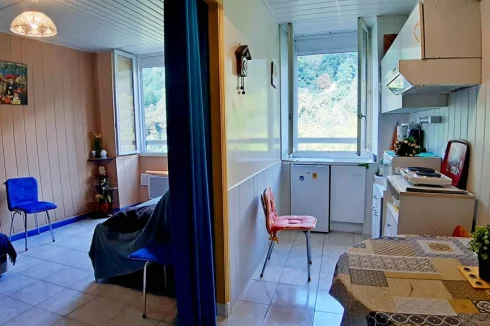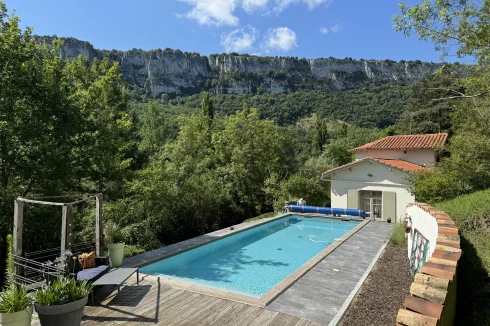New Rules on Building in Risk Areas in France
Tuesday 15 July 2008
With the increased risk of natural disasters, the French Government is toughening its stance on construction in risk areas, a change that also has implications for existing homeowners.
Whether forest fires in the Luberon, floods in the Rhône Valley, or droughts in the Languedoc, it is a sign of the times that the frequency with which natural disasters are occurring has increased in recent years, a situation that most pundits consider is likely to get worse.
In order to respond to the increase in risk, the French Government is slowly putting in place nationwide risk prevention plans governing land use.
Whilst the designation of risk zones in France is not anything new, the process has not always been taken fully on board by local councils, either because of a lack of resources, or a simple lack of political will. As a result, the new plans are being prepared by the county préfectures, ostensibly in consultation with the local councils.
The plans are called Plan de Prévention des Risques (PPR). They will establish areas of the country where there is the risk of a natural or industrial disaster. The PRR divides the area into three planning zones:
- Red Zone – No planning permission permitted.
- Blue Zone – Planning permission subject to conditions.
- White Zone – Planning permission subject to local planning regulations.
Official estimates suggest that less than 5% of the country is likely to be designated a red zone, with the remainder merely subject to stronger planning regulation. However, in some departments of the country, prone to greater natural risks, this percentage will be higher. Once in place there will be greater surveillance of risk areas by officials, and local authorities will required to put in place measures to reduce the level of risk, notably by appropriate infrastructure works.
Thus, in those areas of high risk of fire, a local authority will need to consider the construction of new access roads for fire and rescue vehicles. Around 5,000 communes most at risk now have a plan in place, and others are in various states of completion.
Conflict with Local Plan
There is already evidence that some new risk plans conflict with the designation of land use contained in existing local council plans, either because the local plan is not comprehensive, or because it does not sufficiently take into account the higher level of risk that is now apparent.
Officials have confirmed to us that where there is a conflict between a local plan and a risk prevention plan, then the latter will take precedence. Local councils will be required to bring their local plan in conformity with the risk plan.
Accordingly, even though a local council plan may state that construction can take place, no planning permission will be granted if it conflicts with the rules set out in the risk plan. Indeed, it would appear that if local councils proceed to grant consent, contrary to the risk plan, then it may well be subject to a legal challenge by the préfecture.
Thus, in the Var, where some local councils have granted planning permission, contrary to a local risk plan in the course of preparation, Government planners are bringing cases to court to have the permission overturned. In some of the worst cases, the Government may even decide to demolish homes, as is occurring in the village of Pertuis in the Vaucluse, where 36 houses are being demolished because of the risk of flooding from the River Eze. In Vaucluse at Sablet, a camping site abandoned because of flooding in 2002 is being demolished.
The cost of the two operations to the Government, including compensation to owners, is around €11 million.
In addition, the elaboration of a risk plan also has implications for existing homeowners, who may find that they are unable to construct a new addition to their dwelling, or that it is subject to tougher regulation.
If your home happens to be located in high-risk zone then, in the event of a flood or fire that destroyed the property, there is no guarantee that you would be able to obtain planning consent to rebuild it.
The preparation of a risk plan may also affect the valuation of the property, and the insurance cover that it is possible to obtain although, in the vast majority of cases, the risk areas are well-known to the insurers and factored into existing premiums. Existing owners wanting to know about their local risk plan should visit their mairie or préfecture.
Prospective buyers will normally be informed, as a report on natural or ‘technological’ risks form part of the statutory survey reports an owner is now required to produce as part of the sale process. However, as many plans are in the process of elaboration, if you are in any doubt as to the possibility of the property being in a risk area, then you would be best to contact the préfecture directly, and discuss your concerns with them.
You can also consult directly a website created by the French Ministère de l’Ecologie, which provides information on risk areas, although the information on the site is not always easy to interpret, and may not be entirely up-to-date.
Thank you for showing an interest in our News section.
Our News section is no longer being published although our catalogue of articles remains in place.
If you found our News useful, please have a look at France Insider, our subscription based News service with in-depth analysis, or our authoritative Guides to France.
If you require advice and assistance with the purchase of French property and moving to France, then take a look at the France Insider Property Clinic.





